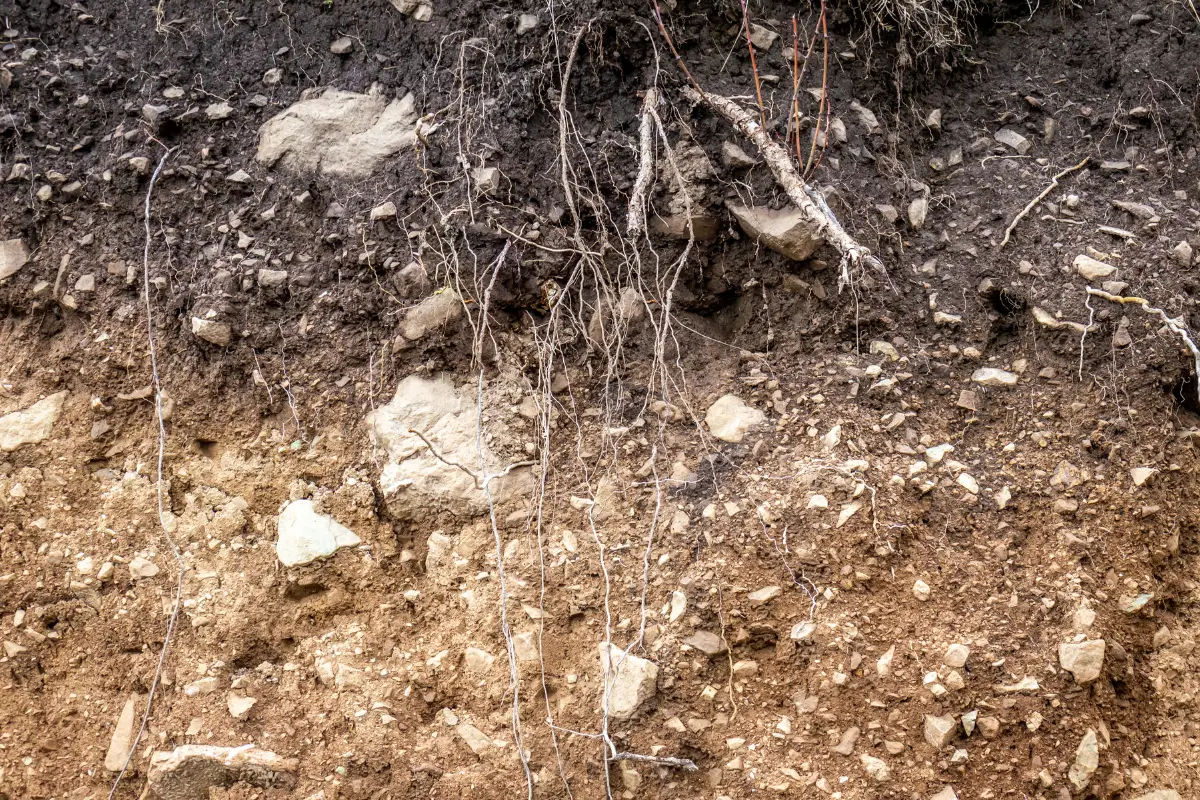The best fertilizers for fescue grass use a slow-release formula since it keeps feeding the grass for several months. Then, you want to choose a 3-1-2 (N-P-K) option. You also should use different amounts of your fertilizer depending on the season.
Taking care of a fescue lawn doesn’t need to be a hassle.

After reading, you’ll know what type, how much to apply, and when to get the best results with your grass.
Table of Contents
What Are The Best Types of Fertilizer For Fescue?
If you’ve purchased fertilizer before, you’ll know that the bags list the percentages of nutrients in each bag. Every fertilizer product should have a portion associated with nitrogen, phosphorus, and potassium. The brand should list it as “N-P-K.”
When taking care of fescue grass, you must choose a specific NPK ratio. Most plants prefer different ratios and will grow faster and healthier when you select the correct one.
Fescue requires that you use a fertilizer consisting of three parts nitrogen, one part phosphorous, and one part potassium. An example would be 12(n)-4(p)-8(k).This NPK ratio is perfect for your fescue grass to thrive.
It would be best to use a slow-releasing fertilizer option. These formulas release nutrients into the soil over time, which is better for the fescue. The best option would be to have at least 30% of the nitrogen as slow-releasing, although you can always go higher.
In short, the best fertilizer for your fescue uses a 3-1-2 NPK ratio and is slow-releasing. Now that you know what fertilizer you’ll want to get, you’ll need to learn how much to use.
Prices pulled from the Amazon Product Advertising API on:
Product prices and availability are accurate as of the date/time indicated and are subject to change. Any price and availability information displayed on [relevant Amazon Site(s), as applicable] at the time of purchase will apply to the purchase of this product.
What Is A Fescue Lawn?
Fescue lawns consist of tall fescue, a cold-season grass that can grow anywhere. It’s hardier than many other kinds of grass, making it best for areas with extreme weather conditions. It even resists drought and does well in the shade.
Even though it’s durable grass, you’ll need to take care of it. Part of that process is using fertilizer, which “feeds” the fescue grass. After, you should water it to help the nutrients spread out evenly.
In short, fescue is simply a kind of grass that you may have in your yard.
Why Does Fescue Grass Need Slow-Releasing Fertilizer?
You can use any fertilizer on your fescue, but slow-release will always suit it the best.
This option deposits nitrogen in the soil over a more extended period, so your fescue always has the nutrients it needs whenever it needs it.
That way, your lawn stays green and fresh-looking. Without regular fertilizer applications, it can appear dull, turn yellow, or even become crunchy. Slow-releasing fertilizer helps to prevent that.
How Much Fertilizer Do You Apply on Fescue?
First, you’ll want to check how much fertilizer you receive with each bag.
For it to thrive, fescue needs at least three pounds of nitrogen per 1000 square feet annually, so you’ll need to work out how much nitrogen is in every bag you have. The amount you apply also varies between the seasons.
Generally, you want to apply a single pound of nitrogen for 1000 square feet during the winter to fescue. During the spring, you’ll need 1.5 pounds of nitrogen per the same amount of space. It’s the same during the autumn months.
You can determine how much nitrogen is in a bag by using the NPK ratio and the weight of the fertilizer, which should be on the bag somewhere. Multiply the weight and the nitrogen percentage. Then, divide the result by 100.
For example, in a 12-4-8 bag that’s 50 pounds, you’d multiply 12 and 50, then divide by 100. The result is six pounds of nitrogen in the bag.
Next, make sure you know the square footage of your fescue yard. In this example, you can apply one bag of fertilizer to 6000 sq ft. Hence, it gets one pound of total nitrogen, or to a 4000 sq ft.
Lawn with 1.5 pounds of nitrogen evenly spread out. Having more fertilizer than you need is fine since you can save it for the next application.

How Can You Determine the Area of Your Fescue Lawn?
You can easily find the square footage of your fescue lawn by measuring its length and width, then multiplying them together. For example, say your yard is 150 feet long and 80 feet wide. You’d have an area of 12000 sq ft.
Once you know the square footage your fescue grass covers, you can determine how many bags of fertilizer you’ll need to feed it properly.
When Do You Apply Fertilizer on Fescue Grass?
You’ll want to apply fertilizer to fescue a few times during the year. In doing so, you’re ensuring that the grass always has the nutrients it needs to grow well. Many gardeners recommend fertilizing fescue at the end of winter, in the middle of spring, and the early fall.
For late winter, the best time to apply is in late February. Then use it around April 1st, about five weeks from the previous fertilizer application.
Finally, apply fertilizer to fescue grass in early September. You don’t need to worry about doing it again until February.
It’s worth noting that fescue grass grows the most during the colder months, so you want to ensure it has access to ample nutrition before winter hits.
Overall, you’ll need to space out your fertilizer applications. You don’t want to overload the fescue, but it still needs consistent nutrients.
Many gardeners and lawn care experts write down a schedule to assist them in tracking applications.
Do You Water Fescue After Fertilizer?
You must water your fescue after applying any fertilizer. The water runs across the fescue and pulls the nutrients into the soil as it soaks into the ground. From there, the fescue can absorb nutrients through its roots.
Watering your fescue after using a fertilizer can prevent your lawn from getting all the nutrients. So, skipping this step can waste some of the nutrients in the fertilizer. It’s best to always water afterward because of this.
Is Applying Fertilizer in Winter Safe For Fescue?
Applying fertilizer to fescue won’t kill your yard as long as you do it when it’s above 50°F (10°C). Most years, you must wait until late February to get the best results. Sometimes, you may need to hold off until March.
Fertilizing fescue during the winter can give it enough nutrients to strengthen its roots, which helps with overall growth. The fescue will store unused nutrients and continue growing well during the year.
So, yes, you can safely and efficiently apply fertilizer to fescue in the winter. You need to make sure that you check the temperature before you do. The water will freeze if it’s too cold, so you must wait until winter’s nearly ended.
What’s the Best Way To Maintain a Fescue Yard?
So, let’s summarize the best way to maintain your fescue yard. Here’s what you can do:
- Choose a 3-1-2 NPK ratio fertilizer
- Make sure it’s slow-releasing
- Apply the fertilizer throughout the year in
- Late February
- April
- September
- Water immediately after application
- Ensure your fescue gets about three to five pounds of nitrogen annually
If you can do all that, your fescue lawn will look outstanding. It may seem like it takes a lot of effort before you start, but fescue grass is easy to grow, even easier than many other common lawn grasses.
How Can You Thicken a Fescue Yard?
How you take care of your fescue grass will impact how it looks. If your grass is sparse, you can take a few different actions to thicken it.
First, we recommend doing a soil analyst test. You’ll discover what nutrients your soil needs.
Then, start a regular fertilizing routine. Your fescue needs nutrients to grow thicker and survive. It can thin out when it’s not getting enough.
Next, ensure your lawn gets enough water without drowning the grass.
Lastly, you’ll want to mow frequently. Doing so encourages the grass to spread across the ground, making your fescue thicker.
You’ll also want to use the correct lead blade settings, so it doesn’t cut more than ⅓ of the grass at a time. More than that can cause the grass severe stress over time, leading to a thin fescue yard.
The more effort you put into your fescue lawn, the nicer it’ll look. This grass multiplies rapidly, so it won’t take long to thicken once you implement a care routine.
How Many Kinds of Fescue Grasses are There?
Finally, two main types of fescue grasses are available, so you’ll need to know what your yard consists of. Your fescue is most likely the broad-leaf type, which includes tall fescue. You can use this article to take care of the grass well.
Fine fescue is slightly less common because it’s less durable than broad fescue. It won’t resist heat, cold, and droughts nearly as well.
You’ll want to add a yearly application of sulfur to your fertilizing routine with this kind of fescue.
Conclusion
Fescue is simply a kind of grass found in your garden and to properly care for it you’ll need the correct fertilizer. The best fertilizer we’ve found for your fescue uses a 3-1-2 NPK ratio and is slow-releasing. You must water your fescues after fertilizing.
We recommend not fertilizing your fescue until the cold weather passes, fertilizer will have no effect if the weather is below 10 degrees. wait till late February for the best results.
For it to thrive, fescue needs at least three pounds of nitrogen per 1000 square feet annually. You can easily find the square footage of your fescue lawn by measuring its length and width, then multiplying them together.
- How to Build a Planter Box for Bamboo: A Step-by-Step Guide

- Can Robotic Lawnmowers Handle Steep Slopes?

- Do You Need a Specific Lawn for a Robotic Lawnmower? Expert Advice

- Are Robotic Lawnmowers Safe for Pets and Children? Safety Features of Robotic Lawnmowers

- Why Use Robotic Lawnmowers? Advantages of Using a Robotic Lawnmower

- Is the GARDENA SILENO City 300 Cordless or Corded? A Clear Answer















